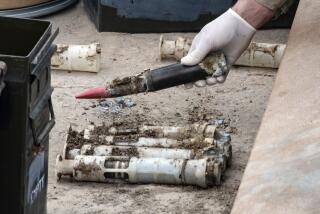Dangers, Advantages of Plutonium 238
- Share via
What makes plutonium so notorious? With hundreds of particles in the nucleus (compared to one, for say, hydrogen), plutonium is a huge, ungainly, complex atom.
In fact, so many particles are crammed into plutonium’s nucleus that the center cannot hold. The inter-atomic forces that normally keep atomic nuclei glued together aren’t strong enough to keep the atom intact. Over time, the atom disintegrates, emitting radiation and sometimes splitting in two--setting off the chain reaction that powers nuclear bombs.
The plutonium on Cassini is not going to explode like a nuclear bomb, experts say. Bomb-grade plutonium 239--so named because it has 239 particles in the nucleus--splits and sets off reactions far more readily than the Pu 238 riding on Cassini.
However, Pu 238 spits out radiation at least 250 times faster than bomb-grade plutonium. As the atom falls apart, it emits alpha particles--small clumps of nuclear particles--with enormous energy. That energy provides heat and electricity for the instruments on Cassini, as well as the Mars Pathfinder, the Apollo moon flights and other NASA missions. Cassini carries more plutonium than NASA has ever lofted into space.
But although Pu 238 is the “workhorse of the space program,” as its discoverer, Glenn Seaborg, calls it, the alpha particles it emits are extremely dangerous to living tissue and DNA. Lodged in the lungs or bone, Pu 238 continues to emit alpha particles for decades, wrecking havoc with the delicate machinery within cells.
Earth’s atmosphere already holds as much as five tons of plutonium, a legacy of the nuclear bomb testing of the 1950s. “I don’t think there’s any obvious signs of damage,” said physicist Philip Morrison of the Massachusetts Institute of Technology. Dozens of atomic bomb workers ingested plutonium during World War II, said the 85-year-old Seaborg, including himself. And many are still walking around to tell the tale, he said.
However, pediatrician Helen Caldicott, who founded Physicians for Social Responsibility, points out that most cancers don’t appear for many decades after exposure to a carcinogen, and the delayed effects are only now beginning to surface among the general population exposed to the nuclear fallout from tests. “We are seeing increased cancer, particularly testicular cancer in men,” she said.
The medical profession, she said, should take the link between nuclear fallout and increased cancer more seriously. “[They aren’t] putting one and one together,” she said.
Meanwhile, she said, the plutonium from the 1950s’ tests continues to circulate in the atmosphere. “Do we want to add more to it?” she asked.




